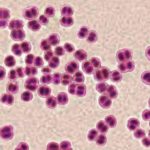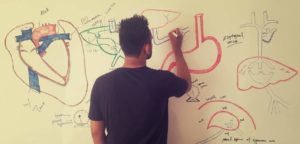Neisseria Meningitidis
Neisseria meningitidis is a gram-negative diplococcus 0.6-1.5 µm in diameter. These are considered true human pathogens. Because
Virulence Factors of Neisseria Meningitidis
These organisms possess pili and adhesions for adherence to host cells. They also produce endotoxins and resist destruction within phagocytes. Neisseria meningitidis also produces a capsule to resist phagocytic engulfment. because
Are you a medical student, doctor or a nurse? Do you want to master medical and clinical sciences?
Join us today and start boosting your medical knowledge with the world’s best medical lectures.

Learn More
Infections
N. meningitidis infects the nasopharynx of humans causing a usually mild or subclinical upper respiratory infection. Colonization of the nasopharynx may persist for months. Neisseria meningitidis (the meningococcus) is the causative organism of meningococcal meningitis, because there are 2000 and 3000 cases of meningococcal meningitis per year in the U.S. In about 15% of these individuals, the organism invades the blood and disseminates, leading septicemia and from the there may cross the blood-brain barrier causing meningitis. Petechial skin rash appears in about 75% of the cases. Because
Isolation and Identification
A gram stain of cerebrospinal fluid or petechial skin lesions. Cultures are taken from the nasopharynx, blood, cerebrospinal fluid, and skin lesions. Typically cultures are done on an enriched, a non-selective medium such as blood agar or chocolate agar grew in 3-7% carbon dioxide. MTM Chocolate agar is also sometimes used for isolation. And thus medium to large, blue-gray, mucoid, convex, colonies form in 48 hours at 35-37°C. Because
Are you a medical student, doctor or a nurse? Do you want to master medical and clinical sciences?
Join us today and start boosting your medical knowledge with the world’s best medical lectures.

Learn More
Serological Identification
There are at least 12 different serological groups of N. meningitidis based on their capsular polysaccharides. But over 90 percent of meningococcal meningitis cases are caused by five serologic groups: A, B, C, Y, and W135. Serogroups A and C usually causes the epidemic form of meningitis. Serogroup C is the most common serogroup in North America whereas B is the most common in Europe and Latin America. therefore
Nucleic acid identification: A polymerase chain reaction test to amplify meningococcal DNA. It can also be used to detect N. meningitidis in cerebrospinal fluid or blood. In carbohydrate utilization tubes, N. meningitidis produces acid from both glucose and maltose, but not from lactose and sucrose. The acid end products turn the phenol red pH indicator from red to yellow. N. meningitidis also produces gamma-glutamyl aminopeptidase. therefore
Case Study Questions of Neisseria Meningitidis
Q1. Which bacterium was causing this patient’s illness? Is the finding of meningitis a positive or negative prognostic sign?
A1. The clinical presentation, the finding of meningitis (190 white blood cells/mm³, primarily neutrophils, in the CSF), and the finding of oxidase-positive, gram-negative diplococci growing in the blood strongly indicated that the etiologic agent of this infection was Neisseria meningitidis. because
Q2. Is this organism ever part of the normal oropharyngeal flora?
A2. N. meningitidis is usually considered to be part of the oropharyngeal flora and can be found in 20 to 40% of healthy young adults. During epidemics of meningococcal disease in institutionalized populations such as the military, colonization rate may approach 90%. because
Are you a medical student, doctor or a nurse? Do you want to master medical and clinical sciences?
Join us today and start boosting your medical knowledge with the world’s best medical lectures.

Learn More
Q3. which immunologic abnormalities predispose individuals to infection with this organism?
A3. Most people colonized with this organism mount a humoral response to it. These individuals, therefore, produce bactericidal antibodies, which appear to be protective. Thus the very small percentage of patients who do not make bactericidal antibodies in response to colonization by this organism are at high risk for development of invasive disease. because
Q4. Which serogroup(s) causes illness? The serogroup is based on antigen from which part of the bacterium?
A4. The serogroups most commonly associated with meningitis in the United States are types A, C, Y, W135, and B. The two most frequently isolated serogroups are B(50%) and C(20%). because
Q5. Which prophylactic strategies are useful for large populations?
A5. Vaccination is the mainstay of prophylactic strategies for large populations. Vaccines derived from capsular polysaccharide are highly protective against groups A and C in adults and children over 2 years of age. because
Q6. What are purpuric lesions and a petechial rash, and which virulence factor plays a central role responsible for their appearance?
A7. Petechial rash and purpuric lesions can be a manifestation of disseminated intravascular coagulation (DIC). Thus petechial lesions are pinpoint, purplish red lesions. Purpuric lesions are therefore similar to petechial lesions but are larger probably representing coalescence of a number of petechial lesions. because
Petechial rash, lumbar puncture, purpura, diplococcus, N. meningitidis, WF syndrome, nasopharynx and PCR Because
Are you a medical student, doctor or a nurse? Do you want to master medical and clinical sciences?
Join us today and start boosting your medical knowledge with the world’s best medical lectures.

Learn More
Medical Disclaimer: The information provided on this website (www.MadeForMedical.com) is only for educational purpose and is Copyrights Protected. While we tried hard to write quality articles but still, the articles and the information within them is not guaranteed to be free of factual errors or typos and hence may not be correct. You are advised to independently verify the claims in the articles and make your own conclusion.
